 |
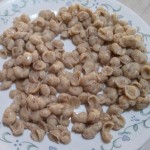 |
This recipe was basically blind luck — I saw an ad for this pasta, and thought, ah, so close! … but I can’t have potato starch or xanthan gum! Well okay. I wonder if I can make my own version? Turns out, yes. Yes I can. Here it is. 🙂
The recipe’s simple enough, but the dough has a big quirk to keep in mind — you need to keep it warm. Some dough needs to be cold to work properly, this dough needs to be warm, the warmer the better. I keep the part of the dough I’m not currently using wrapped up in plastic wrap, and tuck in the top half of a steamer over a burner set on low, so the steam keeps the dough plenty warm. It might seem like a hassle at first, but once part of the dough gets cold you realize how very worth it the effort is — it stiffens up and flakes apart, and blah. Nobody wants that. Keep it warm and it’s a dream, either in an extruder or a roller (I recommend an electric roller, so you have both hands free to handle the dough sheets! — this KitchenAid attachment works great). (You may want to add a little almond flour and tapioca starch to dough you want to extrude, but it depends how sticky and tacky the dough is — too tacky, and it’ll be harder for the extruder to handle.)
You can generally let the shaped dough sit on the counter for a little while; too long, and it’ll stick as the almond oil settles. If you need to fold or otherwise work with the dough once it’s rolled out, I suggest laying it on wax paper dusted with tapioca starch.
You can make this dough either with eggs (as in the lefthand picture) or with flax seed meal and water (as in the righthand picture); both ways work fine, they just yield a slightly different bite and texture. Either version of the noodles works for anything normal pasta will — boil it first (or freeze it and then boil it later), then you can bake or sautee it if you like — just make sure to separate out the noodles pretty quick once you take them out of the water, or they’ll stick together. This makes smaller noodles like macaroni or seashell noodles generally better behaved than long noodles like spaghetti or lasagna, since you don’t have to worry about them sticking to themselves in addition to each other. (I usually fish big stuffed noodles like ravioli out of the water one at a time, even, and put them on a cooling rack to finish draining and cool a little — or straight into a waiting skillet to sautee them!)
The one thing not to do with this dough is dry it to store it — the noodles will crumble before they’ll harden. It stores fine in the freezer, though; just boil it for two minutes (three plus with stuffed noodles), instead of the usual one to one-and-a-half.
Last but not least — you can make this pasta dough without any gums at all, locust bean or guar. The dough won’t be as strong, and the pasta won’t have as good a bite, but if you can’t tolerate gums, it might be worth it for you.
And now, for our feature presentation. 🙂
Paleo Pasta
Yield: 4 oz
Ingredients:
- 1/2 cup almond flour
- 1/2 cup tapioca starch
- 1/4 tsp guar gum
- 1/4 tsp locust bean gum
- pinch (1/16 tsp) salt
- 1 egg, OR 1 T flax seed meal and 3 T water
Directions:
1. First, set up the steamer to keep the dough warm and handy in once it’s made; heat on high till the water boils, then turn it down to low. You don’t want the dough to be so warm it cooks or you can’t handle it easily. Set up your extruder or roller, or, in a pinch, grab a rolling pin and some wax paper. If you’re planning to cook some or all of your pasta right away, start the water boiling now; if you’re planning to freeze some or all of it, get some plastic baggies to store it in.
2. In a food processor, pulse together the dry ingredients (almond flour, tapioca starch, guar gum, locust bean gum, salt, and flax seed meal if you’re using it), until the mixture moistens slightly as the almond flour lets out some oil.
3. Add the egg (or, if using flax seed meal, the water) and run the food processor until the dough is fully combined. Wrap the dough in plastic wrap and put it in the steamer to keep warm. Your dough should feel smooth and look like this (with speckles and a different color if you’re using flax):
4. Now it’s time to shape the dough, be that in an extruder, with a roller, or with a rolling pin. Lightly dust your work surface with tapioca starch to keep the dough from sticking (if you’re rolling onto said surface, I recommend using wax paper as well), and only take the part of the dough you’re working with right now out of the warmth of the steamer. (If you want to freeze any noodles, go ahead and bag and freeze them now, as soon as they’re made; you don’t want them to dry any first.)
5. Once your water’s at a rolling boil, add the noodles and stir apart any clumps. They should cook in about 60-80 seconds, depending on thickness; drain them, then immediately spread them out in a single layer so they don’t stick together as they cool. (If your noodles were frozen, boil them 2-3 minutes; if they were stuffed, boil them 2-3 minutes; if they were both, boil them 3-5 minutes.)
6. Serve fresh and enjoy!
A quick aside: If you want to make ravioli with this pasta, this is the method I’ve found works best. Prep your filling and set it aside; then, dust a square of wax paper lightly with tapioca starch, and roll out a sheet of pasta dough thin enough to be a little translucent (setting 4 on my KitchenAid attachement roller, but it’ll vary from roller to roller).
First, lay out the dough sheet flat like so:
Then spoon evenly spaced dollops of filling along one side of the sheet:
Use the wax paper to flip the top half of the pasta sheet down over the bottom, covering the filling. Use your fingers to cup each dollop of filling, pressing the top layer of dough around the filling and onto the bottom layer, to form dumplings, like so:
Then just grab a pizza cutter or pastry wheel, cut the dumplings apart, even off the rough edges, and put the scrap dough back with the rest of your dough in its warm spot to be reused. The dumplings are delicate, so I usually use a spatula to pick them up and move them around, but if you have a more delicate touch than I do it’s probably not necessary.
Happy pasta making. 🙂
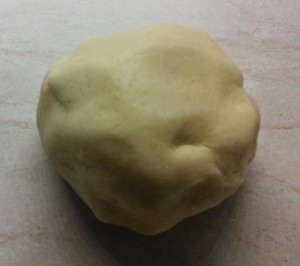
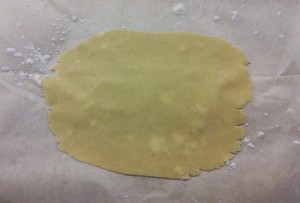
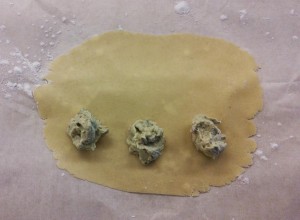
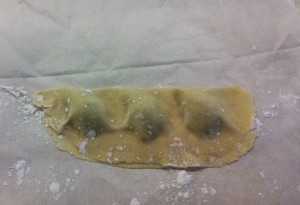
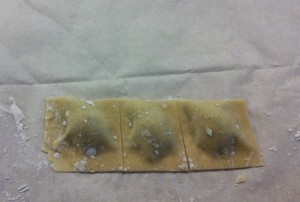

Leave a Reply